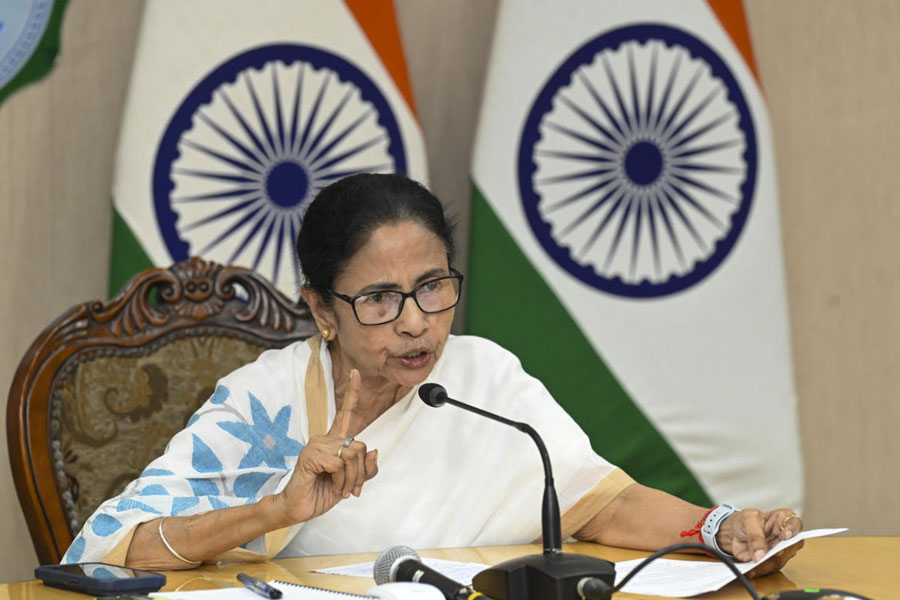 |
 |
| Debesh Das and (below) the Millenium City, an information technology park in Salt Lake, Calcutta |
If you have been thinking of packing your bags and leaving West Bengal for greener pastures, please put your suitcases aside. West Bengal thinks it can create around two lakh jobs in the information technology (IT) and IT-enabled service (ITES) industries by 2010. That’s an ambitious goal — for, at the moment, more than 250 companies in the state employ around 50,000 software professionals.
Not that all the new jobs will come from the software industry. Debesh Das, West Bengal’s minister for information technology, believes that the hardware business (computers, semi-conductors and so on) will be a booming sector with new jobs.
“We want to move beyond software and develop the hardware sector as I see a great future for it,” the minister says in an interview. “We are coming up with an Advanced IT Park near the Indian Institute of Technology, Kharagpur, which will focus on hardware development.”
Minister Das says the state will have a dedicated research and development facility focussed on semi-conductors — called the India Design Centre (IDC) — at Sector V in Salt Lake, Calcutta.
Among other things, the IDC will focus on something that is close to the minister’s heart — the area of very large-scale integration (VLSI). VLSI involves a wide range of disciplines related to hardware, including semiconductor devices, electronic circuits, digital logic, design disciplines and tools for creating complex systems. The minister is an expert in this field and has numerous academic papers on the subject.
Das also says that he is expecting some major hardware players to invest in the state. “Some companies have already set up their manufacturing facilities. We are talking to a few more and we are sure that they will set up their research and manufacturing centres here,” he says.
But growth, the minister believes, must not be limited to Calcutta. The benefits of development, he holds, must spread to other towns and cities in the state.
“It is important to do that if we want to have employment in other parts of the state. We have identified five satellite IT hubs — Durgapur, Haldia, Kharagpur, Kalyani and Siliguri,” he says. Five major IT companies have started working in Durgapur and Das hopes that more will be heading there soon.
The state government has already allotted land for IT parks in Kalyani, Kharagpur and Siliguri. While around 25 acres have been earmarked for the Siliguri IT park, the Kalyani and Kharagpur parks are considerably larger, with 195 acres and 150 acres of land, respectively.
“Durgapur, Kharagpur and Siliguri already have good infrastructure and there are modern amenities for people who work in the IT parks,” he says. Das points out that the land price in Siliguri is already higher than that in Calcutta — an indication of the development there. “Kalyani too will wear a planned city look once the IT park takes off,” the minister promises.
Das, who spent about 17 years in teaching and research, says the government is planning to open more “finishing schools” which have been training engineering graduates in the soft skills required to succeed in the IT and ITES sectors. The institutes have been training people in communication skills and interpersonal skills, for group discussions, imparting information about operating systems, data structures and other software systems.
“Our finishing schools have done exceedingly well. Buoyed by their success, we will be opening more of these in various parts of the state,” he says. Students from arts and commerce, too, will be eligible to join these schools.
The talent pool in the state, he says, is something he is very proud of. Das cites the example of a few companies that are doing better than their counterparts in other parts of the country. “Look at the growth figures of the Calcutta centres of Wipro, HSBC and Tata Consultancy Services. They are the highest in the country. These successes will make other companies realise that West Bengal is the right destination.”
But can the state successfully woo companies when recurrent floods and the city’s infrastructure paint a dismal picture? “The situation in Mumbai was so bad two years ago that nobody could move even an inch there. It was not as bad in Calcutta. Moreover, people in the industry understand that this is a temporary problem. I can confidently say that Calcutta still has the best infrastructure for IT growth when compared to that in any part of the country,” he declares.
Some critics have accused the West Bengal government of being too focussed on creating low-end jobs and of being less interested in promoting home-grown talent in the form of small and medium scale technology companies. Das replies that his ministry wants to “give priority” to medium and small scale companies. “It is with this aim that we granted land in Salt Lake to around 40 small and medium scale companies to establish themselves. We are also providing incentives to smaller companies that employ a certain number of people. All this will help in the growth of medium-sized enterprises. We definitely want to promote homegrown talent,” he adds.
The state has also launched a venture capital fund with a corpus of around Rs 17 crore. “I agree that the state has not produced the likes of an N.R. Narayana Murthy, a Nandan Nilekani or a Ramalinga Raju. But I am very positive about the future. This fund, I am sure, will be utilised by the talented people in the state,” Das says.
Ultimately, West Bengal aims at accounting for around 15 per cent of India’s total IT revenues by 2010. “There is no denying that we are lagging behind other states when it comes to the export of IT and IT enabled services,” he says, when it is pointed out that West Bengal’s contribution to India’s IT exports was around three per cent or around Rs 3,600 crore.
“But we have also registered growth like no other state in the last two or three years,” he says. “Last year the IT sector grew by 42 per cent. This year we expect it to be more than 50 per cent,” says the minister.
Das admits that he enjoys the responsibility of heading a department that can do a lot for the state. “I had set a few benchmarks when I took over as the minister last year, including focussing on hardware development, generating more growth in the software sector and bringing reputed companies to the state. I think we have been quite successful so far on all fronts,” he adds.











